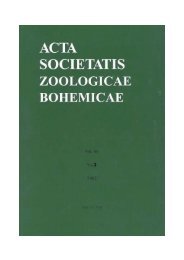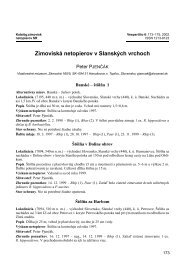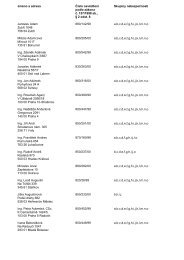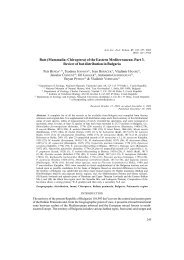Create successful ePaper yourself
Turn your PDF publications into a flip-book with our unique Google optimized e-Paper software.
Arthropods of Burgess Shale type from the Middle Cambrian of Bohemia (Czech Republic)ing the entire surface, becomes markedly denser and composedof smaller reticulae near the margins and in proximityof the lateral carina, where the ridges, forming thecharacteristic reticulae, are thickened.The specimen L36481 (pl. IIH, preserved incompletelength 71.5 mm, coll. Dr. M. Široký) represents fragmentsof two carapace valves approached along the straighthinge line. The very distinct polygonal reticulate sculpturediminishes and becomes denser close to the dorsal marginand near the presumed lateral ridge (the ridge itself is brokenoff). It may be recalled that this specimen was figuredand misinterpreted as a fish fragment by Michálek (1978)in a popular journal, which caused some erroneous storiesabout fish remains in the Jince Cambrian.All other specimens of Tuzoia sp. are fragmentary butshow a typical reticulate sculpture consisting of polygonalfields of different shape and density (most obvious pentagonaland hexagonal polygons, maximum diameter 6–7 mm).Among these specimens, L36484 (pl. IIE, coll. Dr. R.J. Prokop) shows the straight dorsal margin preserved at alength of 49 mm long. The area of denser and smallerreticulae, delimited by stronger ridges near the dorsal margin,is locally up to 8 mm wide, but the increase of marginaldensity is typical and comparable e.g. withMP-S01748 (fig. 1) or L36481 (pl. IIH).A remarkable remain is L36483 (text-fig. 2B, coll. Dr.M. Široký). It is a negative counterpart of the dorsal andposterodorsal parts of a large carapace valve (total preservedlength 111 mm), which shows damaged dorsalmargin terminated by a stout, horn-like spine (length 6mm). Configuration of this spine differs in form and suppressedsculpture from the spine interpreted in VK41 asthe anterodorsal. Consequently, the spine in L36483 is interpretedas the posterodorsal, very similar to the terminationof the fragmentary remain described by Barrande asPilocystites primitius (see discussion below). The polygonalreticulate sculpture shows only a slight tendency to diminishnear the margins (influenced by preservation).Remarks. Although assigned to Tuzoia, the availablespecimens do not show the entire outline of carapacevalves and the number and configuration of all marginalspines. Consequently, a full diagnosis cannot be given andopen nomenclature is used.Among the species described, T. retifera Walcott, 1912,T. guntheri Robison et Richards, 1981, and T. polleni Resser,1930, show analogies in reticulate sculpture, presence ofa marked lateral ridge with diminished and denser reticulaeand configuration of the anterodorsal region. Although thediminishing of the reticulation near and on the surface of thelateral ridge is more marked and occupies a broader band inour specimens, the individual variability of sculpture and itschanges during ontogeny has not been studied in any largerset of individuals of Tuzoia, and, consequently, its systematicsignificance cannot be precisely evaluated. In our view, theincrease of reticulation density, especially near the lateralridge, can increase during the ontogeny, being more markedin large individuals. This is another reason for leaving ourspecimens in open nomenclature.All our specimens referred to Tuzoia sp. indicate largedimensions: the extrapolated length of the carapace valvesranges between 110 and 160 mm, or even more (inMP-S01749 is the preserved length of the incomplete carapacevalve 145 mm, the total extrapolated length 170–180mm). These dimensions are larger than in specimens describedfrom other areas and exceed even the measurementsof the type species T. retifera from the Burgess Shale.Occurrence: Jince Formation, mostly the middlepart. The lowermost find (VK41) derives from the upperpart of the Eccaparadoxides pusillus Zone, about 3 m belowthe Dawsonia bohemica “Horizon” at Vinice nearJince. Most specimens come from the interval between theEccaparadoxides pusillus and Paradoxides gracilis Zones,namely from its upper part at Vinice and Vystrkov nearJince (the single specimen from Velká Bába near Hostomiceprobably came from the same level). Later specimensoccur in the Paradoxides gracilis Zone (Vinice) andthe latest fragments come from the Ellipsocephalus hoffibearinglayers at Koníček.Comments on Pilocystites primitius Barrande, 1887Text-fig. 5Barrande (1887) based the genus Pilocystites on a singlefragmentary specimen named Pilocystites primitiusBarr. from the shales with “Paradoxides” belonging to his“faune primordiale” from Ginetz (recte Jince). He regardedthe fossil as an incomplete calyx of a cystoid and in itsdescription he stressed the composition of irregular polygonalplates without distinct pores (Barrande 1887, p. 185).Barrande’s interpretation was understandable, as no similararthropod remains with marked reticulate sculpturewere known in his time from strata of comparable age (theproblematic Dictyocaris Salter, 1860 from much younger,Downtonian, strata, was no firm base for comparison).Jaekel (1899) regarded Pilocystites as a doubtful rootof a crinoid, Ubaghs in Beaver et al. (Treatise, 1967: S493,fig. 323, 2) expressed doubts about the echinoderm natureof the fossil.The original specimen of P. primitius is not depositedin the Barrande collection in the National Museum,Prague, and only the plaster cast – the plastotype L9049 –exists (Barrande noted that the specimen is contained in ablock of shales with a large “Paradoxides” he found aboutforty years ago, i.e. in the 1840’s). Regrettably, all attemptsto find the original specimen were unsuccessful.In our interpretation, based on the plastotype of theoriginal specimen figured by Barrande (1887) in pl. 2, fig.26 and refigured here in text-fig. 5, this is a fragment of acarapace valve of a tuzoiid arthropod, most likely conspecificwith Tuzoia sp. as reported here.The plastotype proper is not of very good quality but itshows a straight edge 51 mm long, representing in ouropinion the incomplete dorsal margin of a carapace valve.The horn-like process on the left edge of the cast can be interpretedas the posterodorsal spine, comparable with thatpreserved in the specimen L36483 of Tuzoia sp. The171








